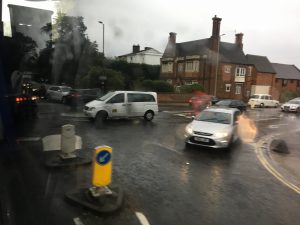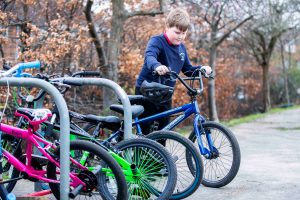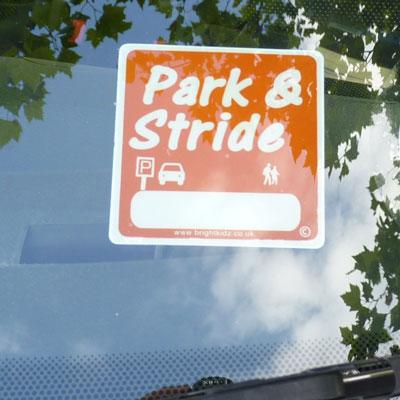Why is it Called the 'School Run'?

4 minute read:
This was the question I asked myself this morning as I walked past a whole row of cars, stuck in a queue near my house.
“Run” makes it sound like they are going quite fast… like it is somehow fun or exciting. It isn’t though.
I looked at the faces of those inside their metal boxes: adults looking tired and fed-up already (it was only 8.40am!) and children looking bored. It made me wonder why they didn’t break out of those boxes and actually move!
Did you know that most people live less than a mile and a half from their primary school? Depending on how fast (or slow) you are, this could take anything between 15 and 25 minutes to walk. I am willing to bet that it takes almost as long to get into the car, drive, stop, drive, stop… and then get out at the school! The great thing about the walk is that it will wake you up, switch on your brain and get you towards the 60 minutes of exercise the government recommends you do every day! Yes, EVERY day. Not only will this make you an incredible learning machine at school, it will mean you are less tired when you get home. It will keep you fit and healthy, balancing all those yummy sweets and crisps you like to eat!
The really good thing about this idea of walking to school is that it would take so many cars off the road. The latest figures suggest that people driving their children to school puts an extra 2 million (that’s 2,000,000!) tonnes of CO2 into the atmosphere every year. Just the journeys to school and back! Imagine how clean the air might be if those 2 million tonnes stopped being pumped out… that would make breathing easier, improve the look of our streets (most of the dirt is from exhausts and tyre debris) and make our local areas a lot safer to be out in.
That sounds like a lot of benefits to me!
If you would like to walk to school, then why not ask your parents or carers if it is something they can help you with? Is there a friend nearby you could walk with? Could you organise a group and all walk together? A parent, carer or babysitter could walk with you some or all of the way. Even trying this for 1 or 2 days a week can really help.
If you live a bit too far out, or the roads are not safe enough to walk the whole way, then why not try Park and Stride? That’s where you park a little way from the school (maybe 2 or 3 streets) and walk the rest of the way. That way you are doing your little bit to get some of the amazing benefits of the walk to school.



Here at Brightkidz we would love to hear your stories of how you have broken out of the metal box and got active on your way to school. Please write down your ideas and email them to us or ask your teacher to let us know what brilliant things you have been doing.
‘Sussed it’ – Questions about ‘Why is it called the school run?’
Please feel free to use this as a resource to support the reading of the blog article in class or at home.
1.What metaphor does the writer use to describe the cars? (A metaphor is when you say that one thing is a different thing to create an image in the reader’s mind)
2.What time of day was it, when she saw all the people in their cars?
3.What is the average distance that people live from their primary schools?
4.How many minutes of exercise does the government recommend children should get every day?
5.How many tonnes of CO2 are created just from cars taking children to school?
6.What causes most of the dirt at the side of the road/ on our streets?
7.What is it called when you drive some of the way to school and walk the rest?
Additional Learning Activity Suggestions:
- Get children to time themselves (or each other) over a set distance, then do the appropriate maths to calculate how long it would take them to walk a mile/ mile and a half. E.g. If they time a walk of 400m, then this is a quarter of a mile and so can be multiplied by 4 or 6 to get the result.
- Children could do their own traffic survey on their way to school/ in the holidays: do they see a difference in the numbers of cars on a certain stretch of road?
- Children can design a poster to encourage others to get their 60 minutes of exercise a day – what can they think of to make this realistic?
- Children could devise their own routes – walking, cycling and Park and Stride maps of the local area. They could use street maps to help (useful map reading practice and area knowledge skills) or even take a walk around with an adult to look at the possible routes to help make journeys to school healthier and better for the environment.
- A homework where families work together to create a pledge for increasing the amount of walking (or cycling, scooting) they do each day. Could a competition be created for those that manage to reduce the days they sit in their metal boxes?
Answers to Comprehension Questions on “School Run” Article:
1.What metaphor does the writer use to describe the cars? (A metaphor is when you say that one thing is a different thing to create an image in the reader’s mind) -Metal box(es)
2.What time of day was it, when she saw all the people in their cars? 8.40am
3.What is the average distance that people live from their primary schools? 1.5 miles
4.How many minutes of exercise does the government recommend children should get every day? 60 minutes per day.
5.How many tonnes of CO2 are created just from cars taking children to school? 2 million (2,000,000) tonnes.
6.What causes most of the dirt at the side of the road/ on our streets? Exhaust pollution and debris from tyres.
7.What is it called when you drive some of the way to school and walk the rest? Park and Stride.